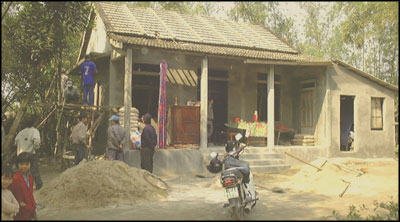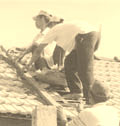Viet Nam

A programme to promote preventive strengthening to protect homes and family investment.
The DWF programme in Central Viet Nam demonstrates a strategy that channels resources, including each family’s own resources into prevention rather than post disaster reconstruction. Building on earlier Viet Nam experience between 1989 and 1993, DWF has been working in the central province of Thua Thien Hué with families and communities to help make people aware of what should be done to reduce vulnerability, aware of how to do it, and how to put this into practice.
 The
programme creates the institutional, technical and financial environment -
with credit for strengthening - in which prevention can take place,
and in collaboration with families demonstrates how strengthening can be done
at a fraction of the cost of reconstruction. The current programme is supported
by ECHO European Commission Humanitarian Aid Office.
The
programme creates the institutional, technical and financial environment -
with credit for strengthening - in which prevention can take place,
and in collaboration with families demonstrates how strengthening can be done
at a fraction of the cost of reconstruction. The current programme is supported
by ECHO European Commission Humanitarian Aid Office.
Present Work
Establishing community capacity to reduce vulnerability caused by storm damage to houses and public building, Central Viet Nam. DWF promotes and supports preventive action to reduce future vulnerability in shelter.
Vulnerability in domestic shelter and small infrastructure in Central Vietnam
is a critical and under supported issue.
- Families are extremely poor but over the past decade have been steadily investing in better houses and living conditions.
- This investment is insecure, because preventive storm resistant techniques are not applied. Small public infrastructure - schools and markets are equally at risk of damage and economic loss.
Context
Each time storms hit the coast of Central Viet Nam flooding and destructive
winds cause major damage. The result is the loss of homes and infrastructure
and the loss of investment in the home and in the quality of life and the
security of livelihoods. Instead of developing and improving their lives,
many villagers are in an almost constant state of recovery.
Overall, although damage in massive storms is hard to avoid, in the more frequent
lesser cyclones the level of damage is much higher than it need be. Prevention
can and does reduce this.
Why the increased vulnerability?
Domestic investment in building materials over the past decade has increased
significantly. But this investment has not been matched by a similar increase
in quality and strength in new houses. Buildings still have many weaknesses
that expose their owners to loss.
This risk represents a level of vulnerability that is both unnecessary and
unacceptable. For all but the largest storms, most damage can be avoided by
preventive strengthening of existing buildings.
DWF addresses this issue through awareness raising, practical demonstration and policy change.
The aim is to reduce vulnerability and damage in houses and small infrastructure:
- Preventive strengthening reduces the risk of damage.
- A reduced risk of damage helps secure family investment in shelter.
- Lower risk enables family investment in improvements instead of repairs.
Action in the communes works to:
- engage solid provincial support
- change strategies to place domestic strengthening as a central issue
Support for the Work

Where?
Central Vietnam - focused on Thua Thien Hué province
How?
- Getting the prevention message across through animation & entertainment.
- Civic capacity building and enhancing village level practical skills.
- Developing a debate about achieving safe building.
- Demonstrating practical and accessible preventive strengthening.
DWF’s focus is on reducing vulnerability through exchange and communication
with the population to promote preventive strengthening:
Animation: A participatory programme in each commune works to stimulate short
and long term awareness of the need to take account of preventive strengthening
in building and rebuilding. Animation uses a large variety of local skills
including theatre, poetry, song, school competitions and special action weeks
around a theme or a specific project such as strengthening a market.
Developing the social and institutional environment: DWF works with beneficiary
families and helps them strengthen their homes, and it works with community
and women’s and farmers unions and local government. Commune Damage
Prevention Committees have been established by DW and play a central role
in coordinating commune activities.
Practical demonstrating: In selected hamlets DW demonstrates with families
how preventive action can realistically be applied on existing homes and village
buildings, showing achievable, durable and affordable strengthening within
the community that respect local habits and resources.
Access to credit: DWF has developed opportunities for access to small credits
for poor families to help them undertake strengthening of their homes.
Training: The programme provides technical training to builders, organisation
and animation training to village leaders, and institutional support to communes.
Working with schools: One focus is on working with rural schools to make children
more aware of the need for prevention, to help teachers integrate the theme
into the school, and to work on making schools storm resistant.
Through the process of animation and demonstration grass roots and official attitudes are changing.
DWF works in collaboration with the Thua Thien Hué Consulting & Designing Construction Company, Hué and the People’s Committee of Thua Thien Hué province. The project builds on experience gained by DWF in flood and storm related work in Vietnam since 1989 on UNDP and Australian Aid supported projects in central and northern Viet Nam.
Support:
DWF actions in Central Viet Nam are currently supported by the EC Humanitarian
Aid Office (ECHO).
Between 1999 and 2002 by Canadian International Development Agency (CIDA)
and the Fondation Aide Viet Nam Canada.
DW, a French NGO, has an office in Hué, Thua Thien Hué province
in Viet Nam.
Contact: Development Workshop, Vietnam
91/44A Phan Dinh Phung, Hué, Thua Thien Hué Province, Viet Nam
e-mail Tel: (84-54) 84 82 31
Viet Nam: much fuller detail

